The ancient city of Assos and the revival of a campsite
- Written by Portal Editor
In order to further prepare for the establishment of camper pitches in Turkey and the Balkans for the purpose of winter accommodation and camper stations available all year round, we also accepted the Eden Hotel Group's invitation to Assos.
During the EMITT trade fair in Istanbul, we learned from various conversations with marketing manager Meltem Öner that there had been a lot of camper activity in Assos 25 years ago, and that the owner of the Eden Group, Mr. Hilmi Selimoglu, even ran a campsite himself had. With the crises surrounding the former Yugoslavia and the subsequent wars, this branch of tourism almost came to a complete standstill due to the unfavourable or impossible travel conditions.
Exploring the ancient ruined city of Assos
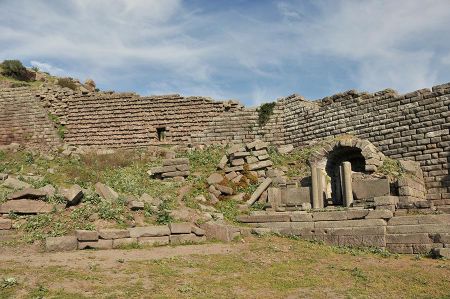 With our idea of revitalizing camping tourism, Mr. Hilmi found more than just open ears.
With our idea of revitalizing camping tourism, Mr. Hilmi found more than just open ears.
After the journey from Izmir, with a stopover in Bergama, there was a correspondingly warm welcome at the small fishing port of Assos, which ended in a tasty fish meal and the first extensive conversations.
Since Mr. Hilmi was initially busy with business the following morning, we decided to spend the morning exploring the ancient ruined city of Assos, which extends over the entire 234-meter-high mountain slope made of dark trachyte above the harbour.
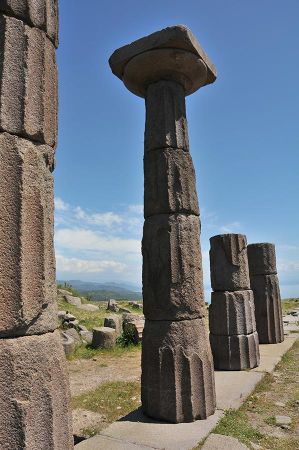 Research within the ruins has shown that the first settlements existed here as early as the Bronze Age. However, the city of Assos was only founded in the 7th century BC by settlers from Methymna from the island of Lesbos, which is almost within reach.
Research within the ruins has shown that the first settlements existed here as early as the Bronze Age. However, the city of Assos was only founded in the 7th century BC by settlers from Methymna from the island of Lesbos, which is almost within reach.
The city of Assos was also a member of the Attic-Delian Sea Alliance, but it played a role in the Greco-Persian conflicts of the 5th and 4th centuries BC. BC did not play a decisive role.
It was only during the uprising of the satraps that Assos became an important city, because in 366 BC the rebellious satrap Ariobarzanes found shelter and protection here. Since around 360 BC, Assos has been ruled and expanded by Eubolos and his successor Hermeias.
Aristotle also lived in Assos at this time.
Roman expansion policy
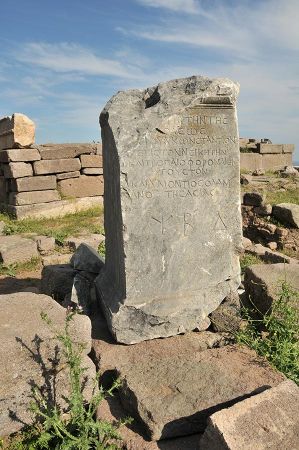 With Alexander the Great's campaigns from Pella between 334 and 241 BC, Assos fell into his and the Seleucid hands that followed him and became their territory.
With Alexander the Great's campaigns from Pella between 334 and 241 BC, Assos fell into his and the Seleucid hands that followed him and became their territory.
Assos belonged to the Attalid Empire of Pergamon until around 133 BC before it was integrated into the Roman Empire as part of the Roman expansion policy.
With the decline of the Roman Empire and the Byzantine Empire that followed, Assos also became the seat of a bishop.
As late as 1306, the Greeks were able to defend the Assos fortress, which was only located in the area of the old Acropolis, against the Ottomans, but shortly afterwards the settlement passed into their possession.
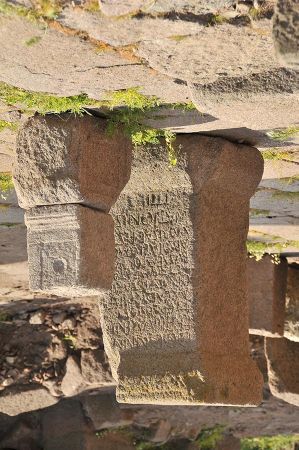 Climbing the mountain on the coastal road, we first reach the village of Behramkale, which is also the frequently mentioned Turkish name of the town of Assos, from where we want to enter the former city centre. Entirely geared towards tourism, locals offer embroidered tablecloths and all sorts of other handicrafts at low prices. It goes quite steeply up the mountain, always following the windings of the narrow village road. What is striking are two mighty towers that were part of the former city fortifications and a very old mosque that was built here after the Ottoman conquest. It dates from the time of Murat I (1326–1389), making it one of the earliest Ottoman mosques ever. It was built using numerous ancient and Byzantine spolia.
Climbing the mountain on the coastal road, we first reach the village of Behramkale, which is also the frequently mentioned Turkish name of the town of Assos, from where we want to enter the former city centre. Entirely geared towards tourism, locals offer embroidered tablecloths and all sorts of other handicrafts at low prices. It goes quite steeply up the mountain, always following the windings of the narrow village road. What is striking are two mighty towers that were part of the former city fortifications and a very old mosque that was built here after the Ottoman conquest. It dates from the time of Murat I (1326–1389), making it one of the earliest Ottoman mosques ever. It was built using numerous ancient and Byzantine spolia.
However, we are magically drawn to the ruins of the Doric Temple of Athena at the highest point of the city mountain. The Temple of Athena was built here between 530 and 520 BC. Some of the restored columns are made of local trachyte, but in ancient times they were covered with white marble stucco. The Athena Temple of Assos is the only known archaic Doric temple in Asia Minor.
Only known archaic temple of Doric order in Asia Minor
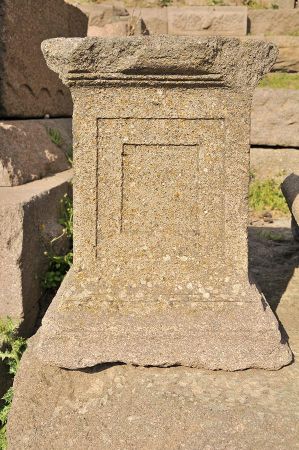 In the urban area, which can be clearly seen from up here, on the slopes between the Agora and the sea, the Agora with halls surrounding it on two sides, the Bouleuterion, the Gymnasium, the theatre and a Roman thermal bath are still quite well preserved. excavated and secured. The view over to the Greek island of Lesbos is also fascinating and unique. The 3 km long city wall with towers and gates is largely still very well preserved and its course can be clearly seen from up here.
In the urban area, which can be clearly seen from up here, on the slopes between the Agora and the sea, the Agora with halls surrounding it on two sides, the Bouleuterion, the Gymnasium, the theatre and a Roman thermal bath are still quite well preserved. excavated and secured. The view over to the Greek island of Lesbos is also fascinating and unique. The 3 km long city wall with towers and gates is largely still very well preserved and its course can be clearly seen from up here.
It was built in many construction phases from the 3rd century BC. BC to Byzantine times. Remains of what is probably still an archaic city wall are also visible. The well-preserved necropolis with burial buildings and an endless number of sarcophagi is also clearly visible outside the city wall.
Since 1981, Turkish excavations have been taking place under the direction of Ümit Serdaroğlu
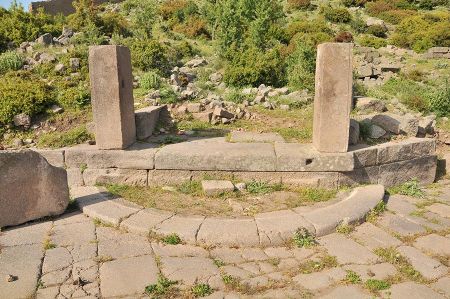 Despite several attempts to descend directly to the agora and the theatre, we cannot find a really accessible passage and decide to return through the village of Behramkale. We are particularly excited about entering the city through the mighty gates and the approximately 8- meter-high city wall and so we reach the section of a cobbled street that is accompanied by an incredible number of sarcophagi to the left of the street. To the left of the city gate, we find a hall-like structure that has a stone bench on three sides, almost like a bus shelter. Whether travellers arriving who had to wait in front of the city gate, which was locked at night, could settle here?
Despite several attempts to descend directly to the agora and the theatre, we cannot find a really accessible passage and decide to return through the village of Behramkale. We are particularly excited about entering the city through the mighty gates and the approximately 8- meter-high city wall and so we reach the section of a cobbled street that is accompanied by an incredible number of sarcophagi to the left of the street. To the left of the city gate, we find a hall-like structure that has a stone bench on three sides, almost like a bus shelter. Whether travellers arriving who had to wait in front of the city gate, which was locked at night, could settle here?
There are still many unanswered questions regarding Assos, even though American excavations took place in Assos as early as 1881-83. Numerous finds, especially parts of the temple sculptures, ended up in the Louvre in Paris and in the museums in Istanbul and Boston. Turkish excavations have been taking place since 1981 under the direction of Ümit Serdaroğlu († 2005). The excavations have been continued by Nurettin Arslan since 2006. Important finds are taken to the Archaeological Museum in Çanakkale.
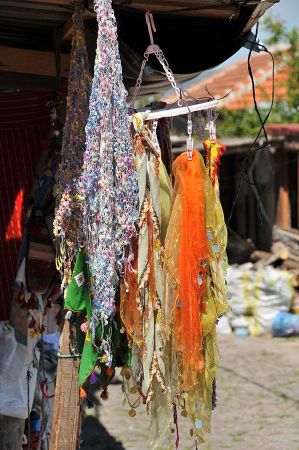 Further down we explore the theatre, which was built into the hillside in typical fashion. Once again, the location of the ruins is typical; you could hardly have found a more suitable place. If the play on offer was too monotonous, the view of the landscape and the island of Lesbos compensated the theatre goer.
Further down we explore the theatre, which was built into the hillside in typical fashion. Once again, the location of the ruins is typical; you could hardly have found a more suitable place. If the play on offer was too monotonous, the view of the landscape and the island of Lesbos compensated the theatre goer.
Time for us to return to our host, who is already waiting for us with the offer of a trip to the three possible locations for a camper pitch. We clearly favour a beautiful olive grove right on the beach next to the hotel, which is easily accessible and, with the connection to the hotel, seems very usable even in winter. After we were able to view some of the rooms in the hotel building, it became clear that an excellent campsite could be created here. A short time later there was a site plan and a map extract with a request to create entries for the first parking spaces in my email account. We will report what happens next. In any case, the location right by the sea with a view of the island of Lesbos and the possibility of hiking to the ancient city of Assos and the beautiful surroundings would be a great location.
Please read as well:
Open paddock at Schleizer Dreieck
Country estates (Villa rusticae) - supply during Roman Empire
Camping in Turkey - once a famous destination!
https://www.alaturka.info/en/turkey-country/marmara-region/6357-the-ancient-city-of-assos-and-the-revival-of-a-campsite#sigProIda2dde7700a
